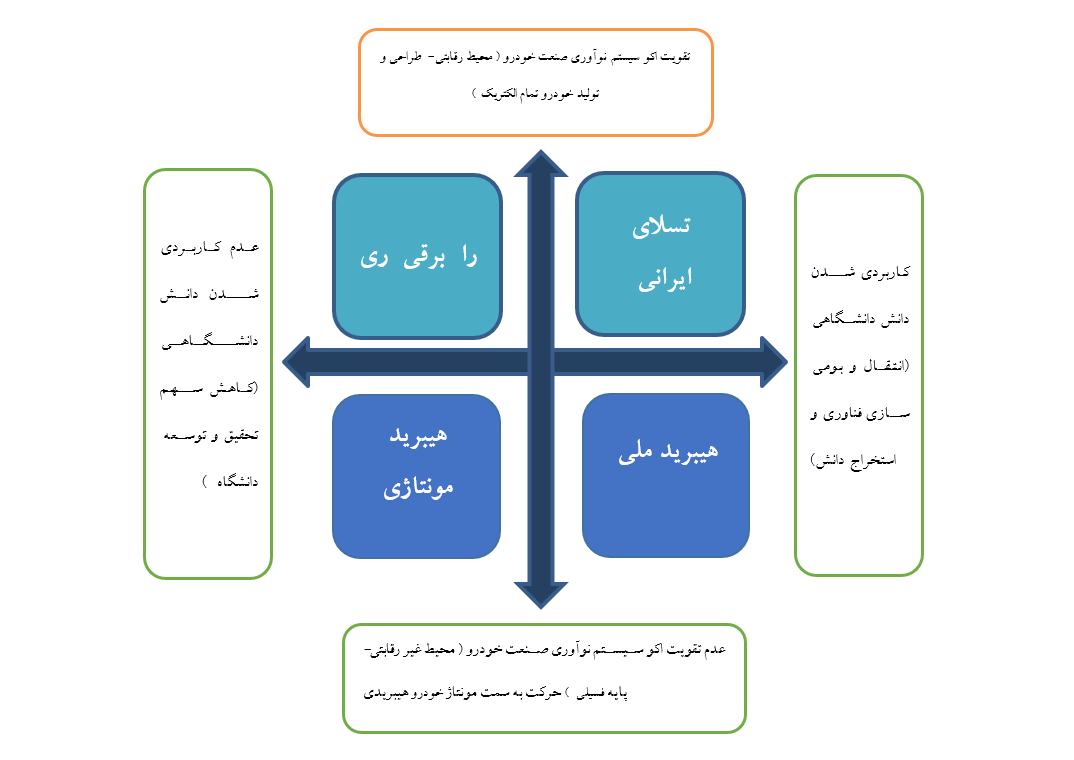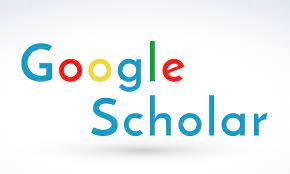آیندهپژوهی توسعه ارتباط دانشگاه با صنعت خودرو ایران
کلمات کلیدی:
آینده پژوهی , ارتباط دانشگاه با صنعت خودرو, روش سناریوپردازی, مدل شبکه جهانی کسب و کار , پیشران های موثر کلیدیچکیده
این تحقیق با هدف شناسایی عوامل کلیدی، تهیه سناریوهای ارتباط دانشگاه با صنعت خودرو ایران و شناسایی استراتژیهای کلیدی برای دستیابی به سناریوی مطلوب در افق ۱۴۱۳ انجام شده است. حاضر با رویکرد آیندهپژوهی و به روش سناریونویسی GBN انجام شده است. برای شناسایی عوامل کلیدی پژوهش از روش نظرسنجی از متخصصان به شیوه مصاحبه نیمهساختاریافته استفاده شده است. از روش «تحلیل مضمونی» جهت شناسایی مضمونهای موجود در دادههای کیفی مصاحبه استفاده شده است. تحلیل دادهها با استفاده از آزمون فریدمن و نرمافزار میکمک برای اولویتبندی پیشرانهای مؤثر بر توسعه ارتباط دانشگاه با صنعت خودرو انجام گردید. در مجموع ۲۶ عامل کلیدی پژوهش براساس نظر متخصصان حوزه دانشگاه و صنعت خودرو از طریق تحلیل مضمونی متون مصاحبهها شناسایی شد. دو عامل شناساییشده با بیشترین میزان اهمیت و عدم قطعیت جهت تدوین سناریوهای پژوهش عبارتاند از: عامل «تقویت اکوسیستم نوآوری در صنعت خودرو»، و عامل «کاربردی شدن دانش دانشگاهی در صنعت خودرو». چهار سناریو برای آینده توسعه ارتباط دانشگاه با صنعت خودرو ارائه شده است: ۱- انتقال و بومیسازی فناوری و استخراج دانش از کشورهای پیشرو و توسعه دانش دانشگاهی با تمرکز بر طراحی و تولید خودرو تمام الکتریک که خودرو تسلای ایرانی را به وجود خواهد آورد؛ ۲- عدم توجه به مشارکت دانشگاه در سیستم نوآوری صنعت خودرو، که منجر به انتقال فناوری و استخراج دانش در محیط صنعت خودرو میشود؛ ۳- استفاده از تحقیق و توسعه و حمایت از پژوهشهای داخلی برای تولید و ارتقای خودرو هیبرید ملی؛ و ۴- عدم ارتباط دانشگاه با صنعت خودرو و ادامه روند کنونی تولید صنعت خودرو با تمرکز بر خودرو هیبرید مونتاژی. در ادامه، استراتژیهای کلیدی شناساییشده برای رسیدن به سناریوی مطلوب ارائه شده و در نهایت سناریوها اعتبارسنجی گردیدند.
دانلودها
مراجع
Seifi E, Ahmadi A, Moazzami M. Identifying the dimensions and components of the application of new technologies
in the fourth generation university. Management and Educational Perspective. 2024;5(4):24-51. doi:
22034/jmep.2024.426783.1282.
Mohammadi kia MH, Imani MN, Mohammadinejad Ganji A. Designing a University Education Pattern based on
Industry Needs in the University (Case Study: Islamic Azad University of Damavand Branch). Sociology of Education.
;10(1):271-9. doi: 10.22034/ijes.2023.549023.1270.
Lee HS, Chernikov SU, Degtereva EA, Zobov AM. A study on brand competitiveness: A comparative analysis of
European and Korean auto brands in the Russian automotive industry. Vestnik St Petersburg University Economics.
;40(1):58-79. doi: 10.21638/spbu05.2024.103.
Seppo, Lilles. Indicator measuring university-industry cooperation. Discussions on Estonian Economic Policy.
;20.
Shah R, Gillen AL. A systematic literature review of university-industry partnerships in engineering education.
European Journal of Engineering Education. 2023. doi: 10.1080/03043797.2023.2253741.
Shirvani Naghani M, Fazli S, Amin Afshar Z. Strategic Planning in Iran's Automotive Industry with a Strategic
Foresight Approach Focused on Science, Technology, and Innovation. Strategic Studies of Public Policy Quarterly. 2019;9(31).
Naghizadeh A, Sheyvandi A, Heidari S, Manteghi K, Zarandi S. From Samand National Continuity to Iranian Tesla:
Scenarios for the Development of the Automotive Industry in Iran. Innovation Management Journal. 2023;11(4):87-113.
Javanmardi, Mousavi, Iranpour. Innovation and University: A Reflection on the Formation and Development of the
Innovative University. University and Industry Quarterly. 2018;11(39-40).
Khoddam, Moeini, Shorahi, Jahromi. Designing Future Scenarios of Iran's Higher Education. Iranian Higher
Education Scientific-Research Quarterly. 2022;14.
Siyah Mafzali A. Examining Thought Structures and Key Concepts in Future Studies and Providing a Framework for
Conducting Future Studies. Management Future Studies Quarterly. 2015;26(102).
Oliver AL, Montgomery K, Barda S. The multi-level process of trust and learning in university-industry innovation
collaborations. The Journal of Technology Transfer. 2020;45(3):758-79. doi: 10.1007/s10961-019-09721-4.
Rybnicek R, Königsgruber R. What makes industry-university collaboration succeed? A systematic review of the
literature. Journal of Business Economics. 2019;89:221-50. doi: 10.1007/s11573-018-0916-6.
Ansari Samani H, Nafer F. Strategies for Developing University-Industry Relations in the Country Based on the
Grounded Theory Method. Innovation Ecosystem Quarterly. 2021;1(4):51-68.
Nikonejad S, Ghaderi M, Azizi N, Neistani M. Analyzing University-Industry Policies in Iran: Proposing a New
Model. Educational Planning Studies Biannual Journal. 2020;9(18):115-50.
Bagheri Majd R, Seyyed Abbaszadeh M, Hassani M. Sustainability Factors and University-Industry Relations
Capacities in the Higher Education System. Innovation and Value Creation Quarterly. 2019;12(6):21-40.
Huggins R, Prokop D, Thompson P. Universities and open innovation: The determinants of network centrality. The
Journal of Technology Transfer. 2020;45(3):718-57. doi: 10.1007/s10961-019-09720-5.

دانلود
چاپ شده
ارسال
بازنگری
پذیرش
شماره
نوع مقاله
مجوز
حق نشر 2024 نشریه پژوهش و نوآوری در تربیت و توسعه

این پروژه تحت مجوز بین المللی Creative Commons Attribution-NonCommercial 4.0 می باشد.










